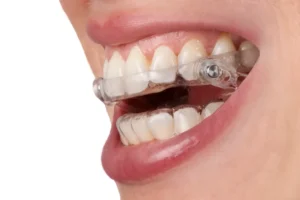A mandibular advancement device (MAD) is an effective solution designed to help individuals manage sleep-related disorders, notably snoring and sleep apnea. This custom-fit oral appliance works by slightly advancing the lower jaw (mandible) forward, which in turn keeps the airway open and reduces air resistance that can cause snoring. Beyond improving sleep quality, using a MAD can significantly diminish daytime fatigue and lower the risks associated with sleep apnea, such as high blood pressure and heart disease. Understanding how this device functions and getting fitted by a professional can make a substantial difference in your overall health and daily functioning.
What is a Mandibular Advancement Device?
A Mandibular Advancement Device (MAD) is a specialized dental appliance designed to alleviate the symptoms of obstructive sleep apnea (OSA) and snoring. These devices are used as a non-invasive treatment modality, offering a practical solution for people who may not respond well to Continuous Positive Airway Pressure (CPAP) therapy. By repositioning the lower jaw (mandible) forward, MADs facilitate a more open airway during sleep, thus reducing the likelihood of airway obstruction.
While initially developed for sleep apnea, these devices have garnered attention for their efficacy in snore prevention as well. Extensive clinical studies have shown that MADs can significantly improve the quality of life for individuals suffering from sleep-disordered breathing.
Definition and Purpose
The primary purpose of a Mandibular Advancement Device is to extend the lower jaw forward to prevent the collapse of the upper airway during sleep. By doing so, it reduces the risk of airway obstruction, which is a principal cause of snoring and obstructive sleep apnea.
MADs are custom-made for each patient, ensuring a snug fit that offers both comfort and effectiveness. The personalized fit is essential to reducing side effects such as jaw discomfort or dental misalignment, which can sometimes occur with generic over-the-counter devices.
Besides its main function, the MAD also has a secondary benefit: improving sleep quality. A more open airway allows for more efficient oxygen exchange, which can lead to deeper, more restful sleep. This is particularly beneficial for those who suffer from fragmented sleep due to repeated apnea episodes.
How It Works
The mechanism behind a Mandibular Advancement Device is relatively straightforward. By repositioning the mandible forward, the device indirectly moves the tongue and other soft tissues in the throat away from the back of the airway. This repositioning prevents the airway from collapsing, allowing for unobstructed airflow during sleep.
The effectiveness of MADs lies in their ability to maintain a forward position throughout the night. Made from durable yet flexible materials, these devices provide a balance between comfort and functional effectiveness. Some advanced models even offer adjustable settings, allowing for incremental adjustments to maximize comfort and efficacy.
Patients often undergo a titration process, where the degree of mandibular advancement is gradually increased until the optimal position is found. This process ensures that the device is not only effective but also comfortable enough for long-term use.
Regular follow-ups with a dental specialist are crucial for monitoring and adjusting the MAD as needed. These follow-ups help address any issues related to fit, comfort, or efficacy, ensuring that the patient continues to benefit from the device over time.
Types of Mandibular Advancement Devices
There are various types of Mandibular Advancement Devices available, each designed to cater to specific needs and preferences. Generally, these devices can be classified into custom-made and boil-and-bite categories.
1. Custom-Made Devices: These are crafted based on a detailed impression of the patient’s teeth and jaw structure. Because they are tailored specifically to the individual, they offer the best fit, comfort, and effectiveness. However, they tend to be more expensive.
2. Boil-and-Bite Devices: These are generally less expensive and can be shaped at home by boiling them in water and then biting into them to create a custom fit. While more affordable, they may not offer the same level of precision and comfort as custom-made options.
Other advanced types include devices with adjustable settings, allowing for incremental changes in the degree of mandibular advancement. These are particularly useful for patients who require fine-tuning to achieve optimal results.
Ultimately, the choice of device will depend on various factors, including the severity of sleep apnea, patient comfort, and budget. A dental specialist can offer valuable guidance in selecting the most appropriate type for each individual.
Understanding the intricacies and benefits of Mandibular Advancement Devices is crucial for anyone considering this form of treatment for sleep apnea or snoring. If you found this article helpful, don’t hesitate to explore our other articles on sleep health and dental treatments.
Benefits of Using a Mandibular Advancement Device
The use of a Mandibular Advancement Device (MAD) has surged in recent years as a popular treatment for various sleep-related disorders. These dental appliances are designed to reposition the lower jaw slightly forward, thereby opening up the airway during sleep. Let’s explore the primary benefits that come with using a MAD.
One of the major advantages is its non-invasive nature, offering a convenient alternative to more invasive surgical procedures. Additionally, MADs have proven effective in reducing the symptoms of sleep-related issues such as snoring and sleep apnea, significantly enhancing the quality of life for many users.
From improved sleep quality to better overall health, the advantages of MADs are supported by numerous studies and clinical trials. Here are some of the most notable benefits:
Reduction in Snoring
Snoring is a common problem that affects both the individual and their sleeping partner. Studies show that up to 40% of men and 24% of women are habitual snorers. A Mandibular Advancement Device can significantly reduce snoring by maintaining an open airway, which decreases the vibrations in the throat that cause snoring.
In most cases, snoring occurs when the muscles of the throat relax excessively, leading to a partially blocked airway. By positioning the jaw forward, a MAD helps to keep the airway open, thereby reducing the frequency and intensity of snoring episodes.
Furthermore, numerous clinical trials have demonstrated that MADs are effective in reducing snoring in a high percentage of users. Patients often report a noticeable decrease in snoring intensity and frequency within just a few nights of use.
Improvement in Sleep Apnea Symptoms
Sleep apnea is a more serious condition characterized by repeated interruptions in breathing during sleep. This can lead to fragmented sleep and a host of related health problems, including cardiovascular issues, daytime fatigue, and hypertension. A MAD can be an effective treatment for mild to moderate obstructive sleep apnea (OSA).
By advancing the lower jaw, the device helps to prevent the collapse of the airway that causes obstructive sleep apnea. Clinical studies have shown that MADs can reduce the apnea-hypopnea index (AHI) – a measure of the severity of sleep apnea – by more than 50% in some patients.
In addition to reducing AHI, the use of MADs can also improve oxygen saturation levels during sleep, resulting in fewer awakenings and a more restful night’s sleep. For many patients, this leads to an overall improvement in daytime alertness and cognitive function.
Non-Invasive Treatment Option
One of the most appealing aspects of using a Mandibular Advancement Device is that it is a non-invasive treatment option. Unlike surgical interventions or continuous positive airway pressure (CPAP) machines, MADs do not require any invasive procedures or equipment.
This makes them a popular choice for individuals who are looking for a less intrusive way to manage their sleep disorders. The ease of use and portability of MADs also make them an attractive option for frequent travelers and those who may find CPAP machines cumbersome.
Moreover, MADs are generally well-tolerated, with minimal side effects. Most users find them comfortable to wear, and they can be adjusted for a custom fit. This adaptability ensures a high level of patient compliance, which is crucial for effective treatment.
In conclusion, Mandibular Advancement Devices offer a range of benefits for individuals suffering from sleep-related disorders. Their effectiveness in reducing snoring and improving sleep apnea symptoms, coupled with their non-invasive nature, makes them a valuable treatment option worth considering. For more insights into sleep health and other dental advancements, be sure to explore our other articles.
How to Use a Mandibular Advancement Device Properly
A Mandibular Advancement Device (MAD) is an oral appliance used to treat sleep apnea and snoring. The device works by gently advancing the lower jaw (mandible) forward, which helps keep the airway open during sleep. Proper use of a MAD is crucial for effectiveness and comfort. In this article, we’ll guide you through the correct usage, common pitfalls, and maintenance tips to ensure you get the most out of your mandibular advancement device.
Correct usage of a mandibular advancement device can significantly improve your sleep quality and overall health. By following the right steps and maintaining the device properly, you can minimize side effects and maximize its benefits. Let’s delve into the step-by-step instructions, common mistakes, and maintenance tips to help you use your MAD effectively.
Step-by-Step Instructions
To get the best results from your mandibular advancement device, it’s essential to follow a systematic approach. Here are the detailed steps you should follow:
- Consult with your dentist: Before using any MAD, it’s crucial to have a thorough dental and medical evaluation. Your dentist will confirm if a MAD is suitable for your condition and will customize the device to fit your mouth perfectly.
- Initial fitting: During your first fitting, your dentist will guide you on how to position the device in your mouth. It’s important to ensure the device feels snug but not uncomfortable.
- Gradual adjustment: Most MADs allow for slight adjustments to advance the jaw gradually. Follow your dentist’s instructions on how to make these adjustments over time, usually starting with minimal advancement and increasing gradually to avoid any discomfort.
- Wearing the device: Wear your MAD every night during sleep. It might feel unusual at first, but consistent use will help you adapt quickly.
- Regular follow-ups: Schedule regular check-ups with your dentist to monitor the progress and make any necessary adjustments to the device.
Common Mistakes to Avoid
Even with the best intentions, there are some common mistakes people make when using a mandibular advancement device. Avoiding these can help ensure you get the most effective treatment possible.
Skipping the initial consultation: Bypassing the professional evaluation can lead to improper device fitting and reduced effectiveness. Always start with a dental consultation to ensure the device is tailored to your needs.
Making rapid adjustments: Adjusting the device too quickly can cause jaw pain and discomfort. It’s essential to follow your dentist’s guidelines on gradual adjustments.
Inconsistent use: Skipping nights or not wearing the device regularly can diminish its effectiveness. Consistency is key to successful treatment.
Maintenance and Care Tips
Proper care and maintenance of your mandibular advancement device extend its lifespan and ensure its effectiveness. Here are some tips to keep your MAD in top condition. Cleaning: Clean your device daily using mild soap and warm water. Avoid using harsh chemicals or toothpaste, which can damage the device. Some manufacturers provide specific cleaning solutions, so follow their recommendations.
Storage: When not in use, store your MAD in a clean, dry place, preferably in a protective case. This helps to prevent damage and contamination. Regular inspections: Check your device regularly for signs of wear and tear. If you notice any cracks or deformities, contact your dentist immediately for a replacement.
By following these maintenance tips, you can ensure your mandibular advancement device remains effective and comfortable over time. For more insights on dental care and sleep apnea treatments, explore our other informative articles.
Common Questions About Mandibular Advancement Devices
If you’re considering a mandibular advancement device (MAD) for managing snoring or sleep apnea, here are some frequently asked questions to help you understand how they work and their benefits.
How does a mandibular advancement device help with snoring and sleep apnea?
A mandibular advancement device works by slightly advancing the lower jaw (mandible) forward. This forward movement tightens the soft tissue and muscles of the upper airway, which prevents obstruction while you sleep. The tightening of these tissues helps keep the airway open, thus reducing snoring and preventing the breathing pauses characteristic of sleep apnea.
Are there any side effects to using a mandibular advancement device?
While mandibular advancement devices are effective for many people, they can cause some side effects, especially when first used. Common issues include jaw discomfort, teeth shifting, and excessive salivation. However, these symptoms often decrease as you get used to wearing the device. It’s important to follow up with your dentist to ensure the device fits correctly and to make any necessary adjustments.

My name is Salman Kapa, a 73-year-old expert in bone regeneration and dental implantology. With decades of experience in the field, I am dedicated to advancing our understanding of oral health and hygiene. Through my research and writing, I aim to contribute to the development of innovative solutions in dental care.




